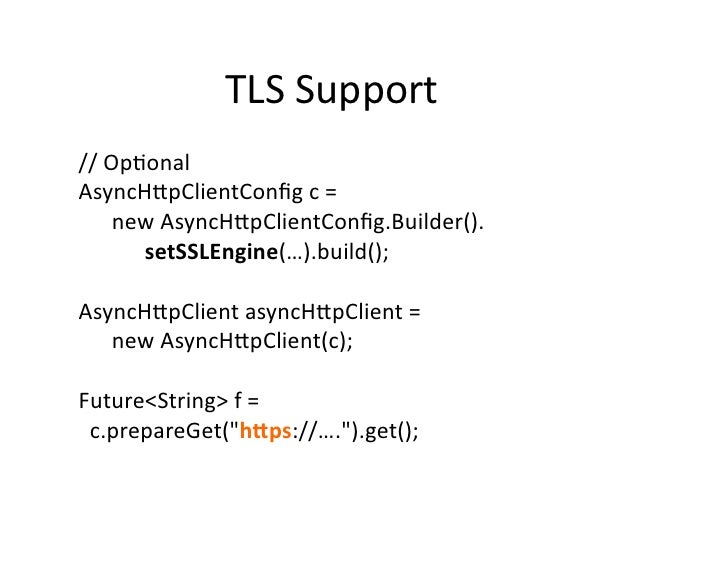
Sometimes a request can even succeed and fail intermittently on the same exact request. A request can get a 200 OK in one scenario and a 409 next time. execute(new WebSocketUpgradeHandler.Builder().Flakiness in REST requests is a common issue. WebSocket websocket = c.prepareGet("ws:///echo") You need to pass a WebSocketUpgradeHandler where you would register a WebSocketListener. You may get the complete maven project for this simple demo from WebSocketĪsync Http Client also supports WebSocket. WhenResponse.join() // wait for completion } catch (InterruptedException | ExecutionException e) )

You can configure listeners to be notified of the Future's completion. The point of using a non blocking client is to NOT BLOCK the calling thread! Setting callbacks on the ListenableFutureĮxecute methods actually return a similar to Guava's.
#Java async http client code#
This is useful for debugging but you'll most likely hurt performance or create bugs when running such code on production. Future whenResponse = asyncHttpClient.prepareGet("").execute() You can simply block the calling thread to get the response. Use the addBodyPart method to add a multipart part to the request.ĭealing with Responses Blocking on the FutureĮxecute methods return a. Have a look at FeedableBodyGenerator if you're looking for a way to pass requests chunks on the fly. .generator.BodyGeneratorīodyGenerator is a generic abstraction that let you create request bodies on the fly.Use the setBody method to add a body to the request. import org.asynchttpclient.* įuture whenResponse = asyncHttpClient.prepareGet("").execute() įuture whenResponse = asyncHttpClient.executeRequest(request) Configurationįinally, you can also configure the AsyncHttpClient instance via its AsyncHttpClientConfig object: import static .* ĪsyncHttpClient c = asyncHttpClient(config().setProxyServer(proxyServer("127.0.0.1", 38080))) ĪHC provides 2 APIs for defining requests: bound and unbound.ĪsyncHttpClient and Dsl` provide methods for standard HTTP methods (POST, PUT, etc) but you can also pass a custom one. You'll then be responsible for closing those shared resources. It's possible to create shared resources (EventLoop and Timer) beforehand and pass them to multiple client instances in the config. Typically, AHC will usually underperform if you create a new client for each request, as it will create new threads and connection pools for each. If you don't, you'll experience threads hanging and resource leaks.ĪsyncHttpClient instances are intended to be global resources that share the same lifecycle as the application. Import the Dsl helpers to use convenient methods to bootstrap components: import static .* Ĭlient import static .* ĪsyncHttpClient asyncHttpClient = asyncHttpClient() ĪsyncHttpClient instances must be closed (call the close method) once you're done with them, typically when shutting down your application.
#Java async http client free#
Basicsįeel free to check the Javadoc or the code for more information.



The library also supports the WebSocket Protocol. The AsyncHttpClient (AHC) library allows Java applications to easily execute HTTP requests and asynchronously process HTTP responses.


 0 kommentar(er)
0 kommentar(er)
